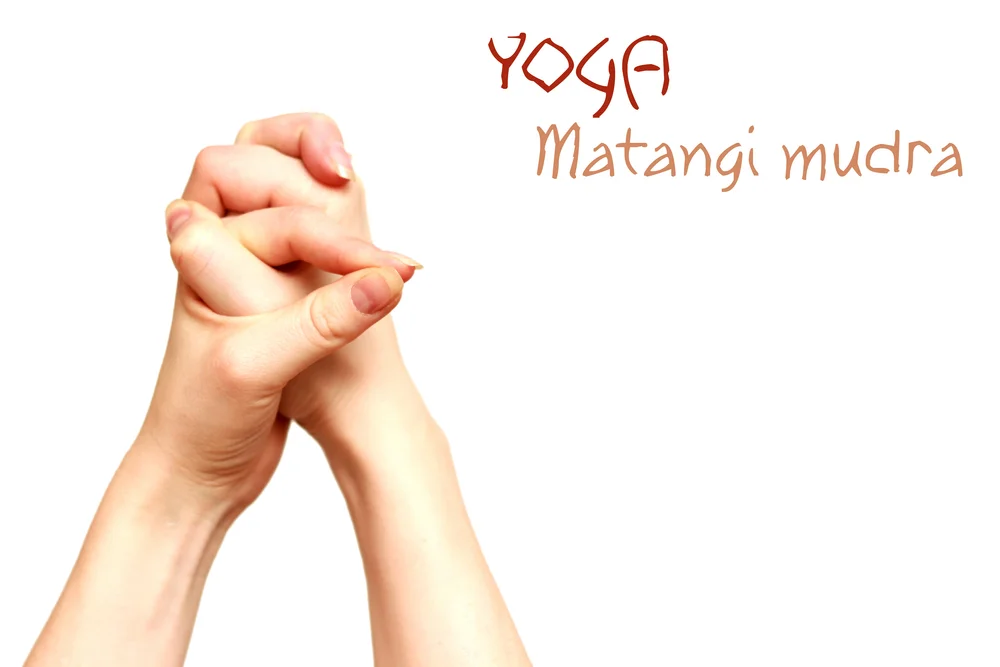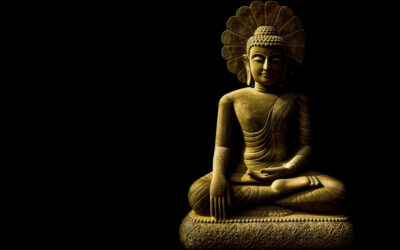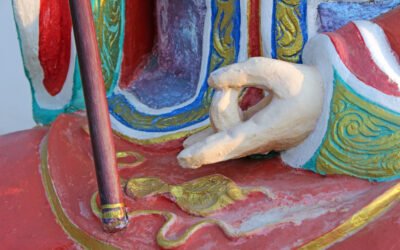Matangi Mudra is a powerful hand gesture in yoga that holds numerous benefits for both the body and the mind. This mudra is named after the Hindu goddess Matangi, who represents the divine aspect of speech and communication. By practicing this mudra one can enhance their communication skills, improve concentration & stimulate the throat chakra. Additionally, Matangi Mudra is believed to have positive effects on digestion and metabolism. However, like any other practice, it is essential to be aware of the potential side effects & take necessary precautions before engaging in this mudra. This article will explore the benefits, side effects, how to perform Matangi Mudra & the precautions one should consider while practicing it.
Benefits of Matangi Mudra.
1. Enhanced Communication.
Matangi Mudra is believed to stimulate the throat chakra, which is associated with effective communication. Regular practice of this mudra can help individuals to express themselves more eloquently, assertively and authentically. It can also enhance one’s ability to listen attentively and engage in meaningful conversations.
2. Boosted creativity.
This mudra is strongly connected to the goddess Matangi, who is revered as the embodiment of creativity and artistic expression. Practicing Matangi Mudra can tap into this creative energy, allowing individuals to explore and express their artistic talents. It can help to overcome creative blocks, inspire innovative thinking and unlock new levels of imagination.
3. Improved focus and concentration.
When practicing Matangi Mudra, the hands are brought together in a specific position, creating a closed circuit of energy within the body. This energy flow is said to help calm the mind, improve focus and enhance concentration. It can be particularly beneficial for students, professionals and anyone seeking to enhance their mental clarity and productivity.
4. Strengthened intuition and wisdom.
Matangi Mudra is associated with the activation of the third eye chakra, which is linked to intuition and higher wisdom. Regular practice can help individuals to develop their intuition, trust their instincts and make more informed decisions in various aspects of life. It is also believed to promote spiritual growth and deepen one’s connection with the divine.
5. Harmonized energy flow.
Mudras work by redirecting the flow of prana or life force energy, within the body. Matangi Mudra specifically focuses on balancing the energies of the throat and third eye chakras. By harmonizing these energy centers, one can experience a sense of overall balance, harmony and wellbeing. It can also help to alleviate any imbalances or blockages that may be causing physical or emotional discomfort.
6. Stress relief and emotional stability.

The practice of Matangi Mudra involves deep breathing and mindful awareness, both of which can help to reduce stress and promote emotional stability. By bringing attention to the breath and calming the mind, individuals can experience a sense of relaxation, inner peace and emotional resilience. This mudra can be particularly beneficial for those dealing with anxiety, anger or emotional turbulence.
| 💡 Tips FreakToFit.com Incorporating Matangi Mudra into a regular yoga or meditation practice can unlock these benefits and support individuals in their journey towards self discovery, self expression and overall wellbeing. It is important to practice this mudra with patience, consistency and a mindful approach to harness its transformative power fully. |
Side Effects of Matangi Mudra.
Like any other practice it also comes with certain side effects that should be taken into consideration. These side effects, although minimal, are important to be aware of to ensure a safe and balanced practice of Matangi Mudra.
1. Overstimulation.
Matangi Mudra can activate and stimulate various energy centers within the body, particularly in the throat and heart regions. If practiced excessively or for an extended duration, it may lead to overstimulation, resulting in feelings of restlessness, hyperactivity or even anxiety. It is crucial to maintain a mindful approach and practice moderation to avoid such side effects.
2. Emotional Release.
This mudra is known to facilitate emotional release by unlocking suppressed emotions and allowing them to surface. While this can be therapeutic and beneficial for emotional healing, it may also lead to temporary emotional discomfort or intensified emotional states.
It is essential to approach these emotions with compassion, patience and seek professional support if necessary.
3. Increased Sensitivity.
Matangi Mudra enhances our sensitivity to subtle energies and vibrations both within and around us. As a result, individuals practicing this mudra may become more perceptive to external influences, including energies from people, environments or electromagnetic devices.
This increased sensitivity can sometimes be overwhelming or draining. It is important to create a balanced and harmonious environment to support oneself during the practice.
4. Physical Discomfort.
Depending on individual body conditions and limitations, certain physical discomfort or strain may occur while performing Matangi Mudra. This can include muscle fatigue, stiffness or even mild pain in the arms, shoulders or neck.
It is essential to listen to your body, modify the practice if needed and consult with a healthcare professional if persistent discomfort occurs.
5. Energetic Imbalances.
Matangi Mudra harmonizes the energy flow within the body but in some cases, it may temporarily disrupt the energy balance. This can manifest as feelings of dizziness, lightheadedness or energy imbalances in specific areas of the body.
It is crucial to practice under the guidance of an experienced teacher or practitioner who can provide insight and support in case of any imbalances.
| 💡 Tips FreakToFit.com Side effects of Matangi Mudra are generally minimal and temporary, especially when practiced mindfully and with moderation. By being aware of these potential side effects and approaching the practice with mindfulness and self-care, one can ensure a safe and enriching experience while reaping the numerous benefits that Matangi Mudra offers. |
How To Do Matangi Mudra?
To practice Matangi Mudra, follow these steps:
Step 1. Find a comfortable seated position either on a yoga mat or a cushion. Ensure that your spine is straight and your shoulders are relaxed.
Step 2. Close your eyes and take a few deep breaths, allowing your body and mind to relax and become centered.
Step 3. Extend your arms forward, keeping them parallel to the ground. Ensure that your palms are facing each other, with the fingers pointing upwards.
Step 4. Bend your middle fingers towards the palm, allowing them to touch the base of your thumbs. The tips of your middle fingers should be touching the pads of your thumbs.
Step 5. Next, interlock your ring fingers and little fingers together, while keeping your index and thumb fingers straight and extended.
Step 6. Rest your hands on your lap, with your palms facing up. Feel the connection between the fingers and the flow of energy that is being created.
Step 7. Take a few moments to focus on your breath, allowing it to become deep and steady. As you inhale, imagine drawing in positive energy and strength. As you exhale, let go of any tension or negativity within you.
Step 8. While holding the mudra, visualize the goddess Matangi, envisioning her as a source of inspiration and guidance. Connect with her energy and qualities, such as creativity, confidence, and clear communication.
Step 9. Maintain this mudra for 5 to 10 minutes or as long as feels comfortable for you. During this time, you can repeat affirmations or mantras related to your goals or aspirations.
Step 10. When you are ready to release the mudra, gently bring your hands back to your lap, palms facing down. Take a moment to notice any sensations or shifts that have occurred within you.
Step 11. Finally, open your eyes and bring your awareness back to the present moment. Allow yourself to carry the energy and intention of Matangi Mudra with you throughout your day.
| 💡 Tips FreakToFit.com Remember, consistency is key when practicing any mudra. Incorporate Matangi Mudra into your daily routine, preferably in the morning or before engaging in creative activities or tasks that require focus. With regular practice, you will begin to experience the transformative power of this mudra and witness positive changes in your life. |
Precautions During Matangi Mudra.
Precautions during Matangi Mudra should be taken to ensure a safe and effective practice. Here are some precautions to consider:
1. Warm up.
Before attempting Matangi Mudra, it is essential to warm up your body. Engage in some gentle stretching exercises to prepare your muscles and joints for the practice. This will help to prevent any potential strains or injuries.
2. Flexibility.
Matangi Mudra requires a certain level of flexibility in the fingers, hands and arms. If you have any pre existing hand or wrist injuries or conditions, such as carpal tunnel syndrome or arthritis, it is advisable to consult with a healthcare professional or a qualified yoga instructor before attempting this mudra. They can provide you with modifications or alternatives that are safe for your specific condition.
3. Gradual Progression.
If you are new to Matangi Mudra, start with shorter durations and gradually increase the time as you become more comfortable. Avoid pushing yourself too far too quickly as this can lead to strain or discomfort in the hands, fingers or arms.
4. Awareness of Sensations.
During the practice, pay attention to any sensations or discomfort you may experience. If you feel any sharp pain, numbness or tingling, release the mudra immediately and consult with a healthcare professional. These sensations could indicate underlying issues that need to be addressed.
5. Breath Control.
Throughout the practice maintain a steady and controlled breath. Deep inhalations and exhalations will help you stay focused and relaxed. Avoid holding your breath or straining during the mudra as this can create unnecessary tension in the body.
6. Mindful Practice.
Approach Matangi Mudra with mindfulness and respect for your body’s limits. Listen to your body and honor its boundaries. Avoid forcing the mudra or trying to achieve an exaggerated hand position. Allow the mudra to unfold naturally and comfortably.
7. Consistency and Patience.
Like any yoga practice, Matangi Mudra requires consistency and patience to experience its full benefits. Practice regularly but do not rush the process. Allow yourself time to adapt and integrate the effects of the mudra into your overall wellbeing.
By following these precautions, you can ensure a safe and effective practice of Matangi Mudra. Always remember to listen to your body, be mindful of any discomfort and seek guidance from a qualified instructor or healthcare professional if needed.
Frequently Asked Questions.
Matangi Mudra can be held for as long as comfortable, ideally for a few minutes. It can be practiced during meditation, yoga asanas or anytime one wants to bring a sense of balance and focus to the mind and body.
Yes, Matangi Mudra can be practiced by anyone, regardless of age or physical ability. However, it is always recommended to consult with a qualified yoga teacher or practitioner before starting any new hand gesture or meditation practice.
Yes, Matangi Mudra can be combined with other yoga practices such as asanas (physical postures), pranayama (breathing exercises) and meditation. It can be incorporated into a yoga sequence or practiced independently as a stand alone mudra.
Matangi Mudra can be practiced in any environment that is calm and free from distractions. It is often practiced in a quiet space during meditation however it can also be done outdoors or in a yoga studio.
Yes, there are variations of Matangi Mudra that involve different finger placements and hand positions. Some variations may focus on specific chakras or energy centers in the body. It is best to learn the basic form of Matangi Mudra before exploring variations.
Bottom Line.
Matangi Mudra is a powerful hand gesture that holds deep significance in the practice of yoga and meditation. By performing this mudra, individuals can tap into the energy of the goddess Matangi and cultivate qualities such as confidence, creativity and intuition. The practice of Matangi Mudra can help individuals to overcome obstacles, enhance communication skills and develop a deeper connection with their inner self. Incorporating this mudra into one’s daily routine can bring about a sense of balance and harmony, allowing individuals to express themselves authentically and manifest their true desires. Whether it is used in spiritual practices or as a tool for personal growth, Matangi Mudra offers a pathway to self discovery and empowerment.

 Workout
Workout
 Meditation
Meditation


 Stories
Stories


 Podcast
Podcast E-book
E-book











